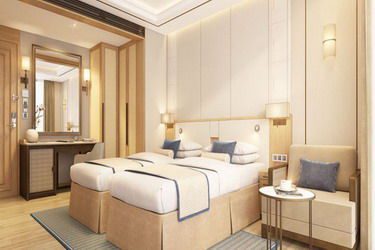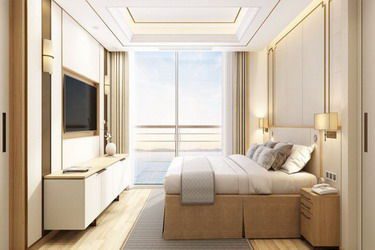from 0 review
Designed to navigate the Mekong River, hosting just 80 guests, Viking Saigon
Cruise offers understated elegance and has been built to reflect the clean, Scandinavian design principles for which Viking is known. Explore one of the world’s most scenic regions in comfort with outdoor verandas, hotel-style beds and public areas bathed in light, offering panoramic views of your surroundings.
Return on board for lunch and scenic cruising along the Mekong; this afternoon we cross over into Cambodia. Onboard activities include a fruit-carving workshop and a presentation about the history of Vietnam. This evening we screen the 1984 film The Killing Fields. (Breakfast, Lunch, Dinner)
This afternoon, join an excursion to the sobering memorial in the Tuol Sleng detention center, a former high school in which thousands of victims of the Khmer Rouge died, and the Killing Fields of Choeung Ek. Or, you may choose to explore the city’s maze of small alleys, markets and busy streets on your own. Enjoy dinner on board, followed by a folkloric performance. (Breakfast, Lunch, Dinner)
Your afternoon is free to explore Phnom Penh’s historic riverfront area with its restaurants, art galleries and silk shops, or perhaps visit the distinctive Central Market or the “Russian Market” where you can buy jewelry, curios, clothes and souvenirs. You might prefer to visit more of the city’s wats (monastery temples): Wat Langka, Wat Botum, Wat Koh or Wat Ounalom, each with its own special character and purpose. Late this afternoon, enjoy an onboard presentation about recent Cambodian history by a local expert. Dinner is served on board the ship. (Breakfast, Lunch, Dinner)
Your afternoon is free to explore Phnom Penh’s historic riverfront area with its restaurants, art galleries and silk shops, or perhaps visit the distinctive Central Market or the “Russian Market” where you can buy jewelry, curios, clothes and souvenirs. You might prefer to visit more of the city’s wats (monastery temples): Wat Langka, Wat Botum, Wat Koh or Wat Ounalom, each with its own special character and purpose. Late this afternoon, enjoy an onboard presentation about recent Cambodian history by a local expert. Dinner is served on board the ship. (Breakfast, Lunch, Dinner)
Set sail in the afternoon, observing daily life along the way. This evening, enjoy a screening of the film l’Amant (The Lover), which prepares you for tomorrow’s visit to Sa Ðéc. (Breakfast, Lunch, Dinner)
Important note*
| Cabintype | Rates (US$/person) |

| Contact us for price |

| |

|
Note*: The price would vary depending on your departures, number of of passengers and cabin type. Please book the tour or contact us for best rate of your itinerary.
Cancellation by Customer
Cancellation is not confirmed till we receive your official email. For cancellations of bookings, the following charges will apply:
Children from 5 years up to 12 years old get:



The rivers you will sail on are subject to seasonal rises and falls of water level, in some places as much as 30 metres. Water levels can change dramatically overnight and a sudden rise can impede our progress upstream considerably and even prevent us from passing under certain bridges. A sudden fall can result in our being unable to get into certain places or go as far upstream as we would hope. Groundings on sandbars are not infrequent and are part of the
excitement of any expedition. Published itineraries are indicational only and subject to sudden change. In such events alternative itineraries will be provided and we do our best to ensure that if a stop is missed we make up for it with another stop.
Passengers are thus forewarned and expected to be flexible and patient. River cruising in Asia can be a dramatic and adventurous experience – not like cruising the controlled waterways of Europe or America. Note also that we operate in areas with little or no developed infrastructure and subject to the strictures of local officialdom. Be prepared for this and it is all more the fun!
For itineraries that include flights in the price of the ticket it should be noted that regional airlines can change departure times or cancel flights at very short notice. In such an event we endeavour to arrange alternative flights but note that this can result in delays often resulting in embarking or disembarking on a different day to that indicated in the itinerary. In such an event the company will cover the cost of hotel accommodation and main meals only, but will not be liable for any claims for compensation for missed days on board a ship, drinks or curtailment of the said itinerary.
We recommend wearing loose and comfortable clothing made of cotton or modern material that can readily cool off sweat and body hear. The type of shoes will depend on the excursion types so best to have both light, open toed shoes as well as good walking/hiking shoes with you. A sun hat is always a good idea to bring along.
Southern Vietnam and Cambodia are warm all year-round, but our other cruise destinations can get chilly during the winter months (Laos, Myanmar or northern Vietnam). Therefore, it is always recommended to bring a pullover or a warm jacket with you during this period.
Many of our cruises include visits to local temples or pagodas. When visiting these holy sites, make sure to wear appropriate clothing which covers your shoulders and knees.
Generally speaking, the rivers we are cruising on in Southeast Asia are very calm and there is hardly any motion on any of our ships. A bit of motion can occur during monsoon rains with stormy winds, but the amount of motion is much less than one would feel during bad weather on the open ocean.
Sea cruises as we offer in Halong Bay or Lan Ha Bay can sometimes encounter heavier waters and ship motion, although this happens very rarely and port authorities will most likely not allow sailing under any such circumstances anyway.
If you are new to cruising or prone to motion sickness, it does not hurt to bring along some motion sickness medication. Drinking a nice hot fresh ginger tea is a natural remedy and tasty alternative our staff is always happy to make for you.
All food and beverage on board is completely safe to eat and enjoy, including the ice cubes you enjoy in your chilled drinks. We do not recommend drinking water straight from the tap anywhere, including onboard. We provide you with complimentary clean drinking water throughout your cruise.
You may want to be bit careful with local dishes as they can be spicier than you are used to from home. Approach new dishes slowly and carefully. If you have a sensitive stomach, then you may like to double check with our chef or onboard managers about specific dishes or meals.
On excursions, it may be a good idea to avoid local foods and snacks unless offered by our tour guides. Besides the above, in general we recommend the following motto for your pre- and post-cruise travelling in the Southeast Asian tropics: boil it, peel it, cook it, wash it or forget it!
The most effective protection from personal contamination is ensuring strict attention to personal hygiene and in particular, frequent and thorough hand washing with soap and water and refraining from hand-to-mouth contact. Colds and other viruses can spread quickly in an enclosed area such as a ship. Continue to practice common-sense hygiene and respiratory courtesy. Wash your hands often and cover your coughs and sneeze. It is recommended that passengers carry anti-bacterial hand sanitizer, which does not require rinsing with water. Use sanitizer frequently and throughout the day, particularly after shore excursions and prior to meals. If you have any questions regarding your health or safety, please do not hesitate to ask your cruise director.
Motion sickness can be a problem for some people when cruising, flying or travelling on coaches and trains and it is a good idea to take precautionary measures. Over-the-counter drugs for treating motion sickness can be purchased at pharmacies in most countries, though a side effect can by drowsiness. Alternatives such as ginger tablets and acupressure wristbands are also available and work well for some people.
Cambodia visas are easily obtained for most travelers on arrival. Note that passports must have a validity of at least 6 months after your last date of travel in Cambodia.
Because travel restrictions across Southeast Asia are constantly changing, we recommend checking with the Cambodia embassy/consulate in your home country for the latest information.
With the exception of visa exemptions, all travelers must arrange their visa prior to arrival in Vietnam. Passports must also have a validity of at least 6 months after your last date of travel in Vietnam.
Because travel restrictions across Southeast Asia are constantly changing, we recommend checking with the Vietnam embassy/consulate in your home country for the latest information.
We recommend at least purchasing travel health insurance which covers both in- & outpatient visits and medical repatriation. Buying additional trip cancellation and interruption coverage may also be beneficial in case you have to cancel your travel plans due to unforeseen circumstances.
We always recommend bringing a travel adapter as a standard item in your travel kit. You can borrow an adapter on board, but these may be limited.
Leave a reply